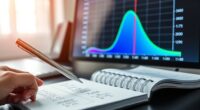If you’re starting with statistics in 2025, explore top beginner books like *Elementary Statistics*, which offers real-world examples, and *First Statistics*, designed for fun and clarity. *Think Stats* helps beginners learn with Python, while *Practical Statistics* links theory to real-world issues. *The Art of Statistics* emphasizes understanding data interpretation. Additional resources include *Stats: Data and Models* and *An Introduction to Statistical Learning*. Keep exploring these guides to build a strong foundation and uncover more insights.
Key Takeaways
- The list features beginner-friendly books emphasizing practical data analysis, critical thinking, and ethical considerations.
- Resources incorporate modern tools like Python and R, focusing on data manipulation, visualization, and privacy.
- Many books include real-world datasets, exercises, and interactive elements to enhance hands-on learning.
- The selection caters to diverse learners, from high school students to aspiring data scientists, with clear explanations and engaging approaches.
- Updated editions and integration with platforms like Kaggle provide current methods and opportunities for active skill development.
Elementary Statistics by Mario F. Triola
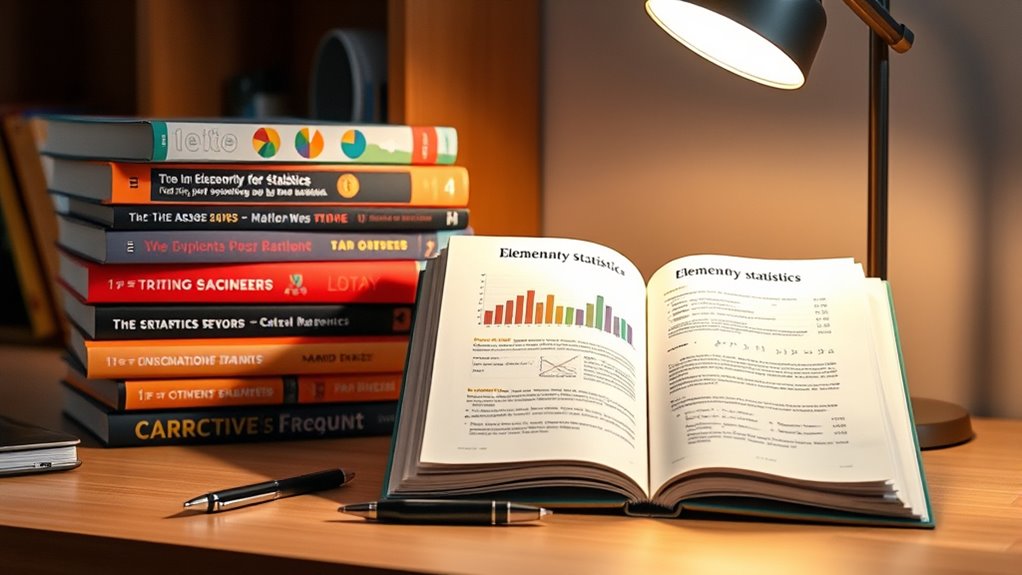
Elementary Statistics by Mario F. Triola offers an engaging and accessible introduction to statistics. You’ll find real-world data integrated throughout, helping you see how statistics applies to everyday life.
The book’s latest editions include new exercises, updated examples, and expanded coverage of current topics like ethics in statistics. Its clear structure organizes content around specific learning objectives, making it easier to focus and understand key concepts.
Supporting resources like videos, practice tools, and online data sets enhance your learning experience. Designed for flexibility, it accommodates different learning styles and integrates seamlessly with platforms like MyLab Statistics.
Additionally, the book emphasizes the importance of understanding breast cancer symptoms and other health-related data, illustrating how statistical analysis can inform medical decisions. As a bestseller, it continues to resonate with students by making complex ideas relatable, connecting theory with practical applications across various fields.
Stats: Data and Models by Richard De Veaux, Paul Velleman, and David Bock
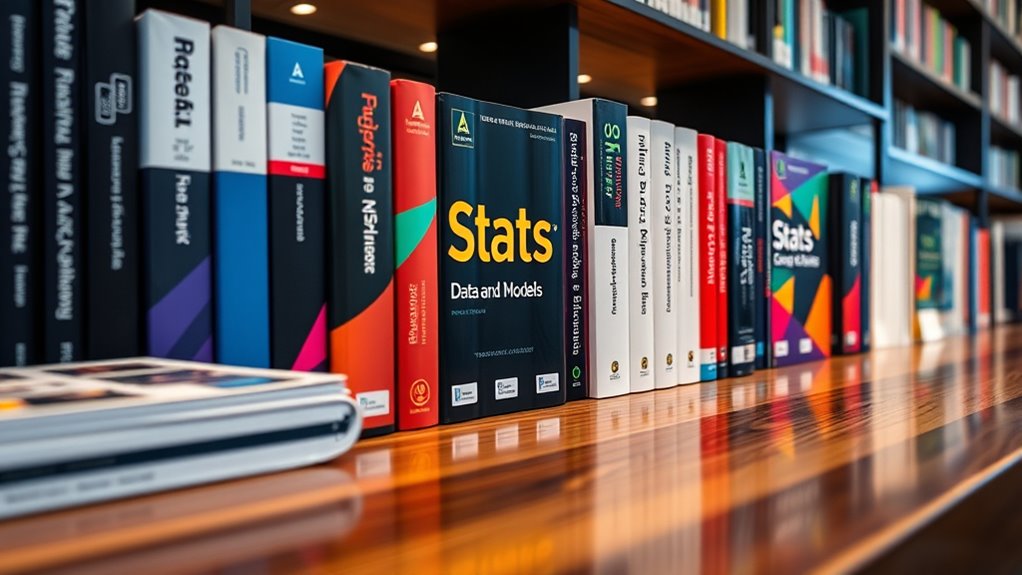
If you’re looking for a clear and engaging introduction to statistical thinking, *Stats: Data and Models* by Richard De Veaux, Paul Velleman, and David Bock is an excellent choice. Now in its 5th edition, the book is praised for its readability and straightforward explanations.
It covers essential topics like understanding data, exploring distributions, and building statistical models, including contingency tables, normal models, and regression analysis. The authors emphasize critical thinking, encouraging you to question data assumptions and interpret results thoughtfully. Additionally, they highlight the importance of attention in data analysis, guiding readers to develop focused and meticulous approaches to interpreting information.
They incorporate technology and humor to keep you engaged, making complex concepts easier to grasp. Ideal for beginners and AP Statistics courses, this book provides a solid foundation for analyzing data with clarity and confidence. Additionally, it introduces potential pitfalls in adopting new payment technologies, helping readers develop a nuanced understanding of data-driven decision-making in real-world contexts.
First Statistics: A Brain Friendly Guide
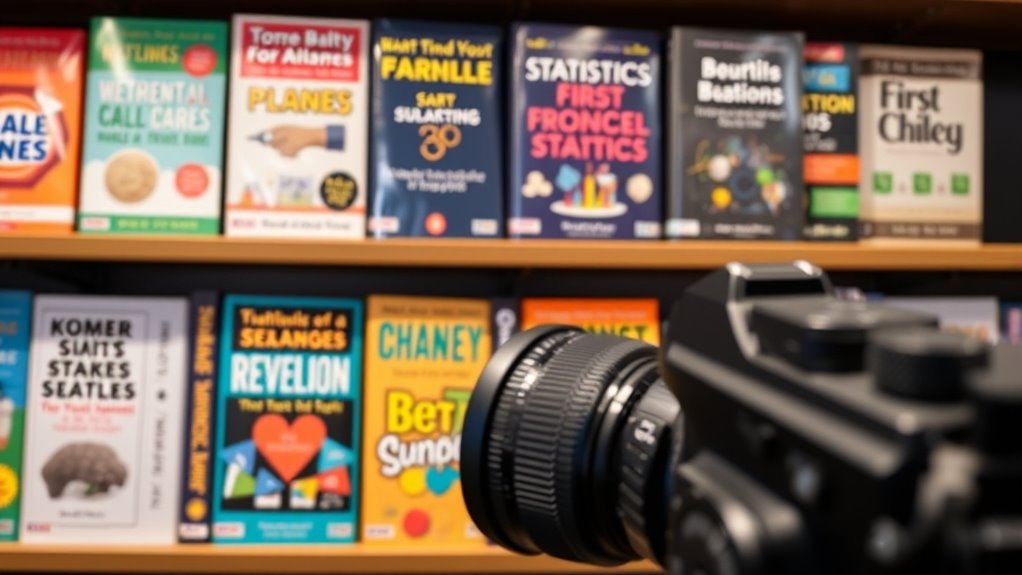
Curious about how to make learning statistics easier and more memorable? *First Statistics: A Brain Friendly Guide* by Dawn Griffiths uses a conversational and humorous tone to break down complex concepts, making them accessible for learners at any level.
You’ll enjoy a structured approach that gradually introduces topics from basic data collection to advanced ideas like hypothesis testing. Engaging real-world examples, puzzles, and visual aids keep you motivated and reinforce understanding.
The book’s interactive elements—quizzes, exercises, and charts—are designed to boost retention and build confidence. Whether you’re a high school student preparing for exams or an adult revisiting statistics, this book makes learning enjoyable and practical.
It’s a perfect starting point for anyone looking to grasp statistics without feeling overwhelmed.
Think Stats by Allen B. Downey

Building on foundational ideas about understanding data, *Think Stats* by Allen B. Downey introduces you to probability and statistics through practical Python applications.
Designed for Python programmers, it emphasizes hands-on learning with real datasets, guiding you through exploratory data analysis, visualization, and modeling distributions. You’ll explore concepts like probability mass functions, cumulative distribution functions, hypothesis testing, and regression analysis, all with clear explanations and code examples.
The book uses case studies and exercises to reinforce your understanding, leveraging Python libraries for probability distributions. As an open resource published by Green Tea Press, it’s accessible and widely adopted in educational settings. Additionally, the book highlights key statistical concepts essential for analyzing data effectively.
Furthermore, understanding the importance of contrast ratio can enhance your grasp of image quality in data visualization, making your statistical graphics more visually impactful.
If you want to learn statistics practically with Python, *Think Stats* offers a straightforward, engaging approach to mastering fundamental concepts.
Practical Statistics for Data Scientists by Peter Bruce and Andrew Bruce

Have you ever wondered how to connect statistical theory with real-world issues? *Practical Statistics for Data Scientists* by Peter Bruce and Andrew Bruce bridges the gap by integrating foundational concepts with contemporary global challenges.
You’ll explore how history, economics, and sociology influence statistics, making the material relevant for today’s data-driven world. The book emphasizes exploratory data analysis (EDA), showing you how to visualize data with boxplots, histograms, and scatterplots—crucial first steps in any project.
It also explains statistical significance, p-values, and hypothesis testing, but cautions against over-reliance on p-values. Using R and Python, you’ll learn to handle different data types, measure variability, and apply regression and correlation.
Practical examples connect theory to real-world economic and sociopolitical issues, enhancing your understanding.
Data Analysis With Python by Wes Mckinney

Data Analysis With Python by Wes McKinney offers a practical guide to manipulating, processing, and cleaning data using Python, making it an essential resource for aspiring data analysts. Focused on hands-on learning, it emphasizes mastering pandas, NumPy, and Jupyter through real-world examples.
As the creator of pandas, McKinney provides deep insights into data structures, from basic to complex time series analysis. The third edition updates content to reflect recent changes, ensuring relevance. Incorporating AI-driven data analysis techniques can further enhance the effectiveness of data projects.
The book is accessible to beginners with some Python basics, offering clear explanations, exercises, and case studies that demonstrate how to reshape, slice, and aggregate data effectively. Understanding grocery store hours can enhance data analysis projects related to retail operations and consumer behavior.
The Art of Statistics: Learning From Data by David Spiegelhalter
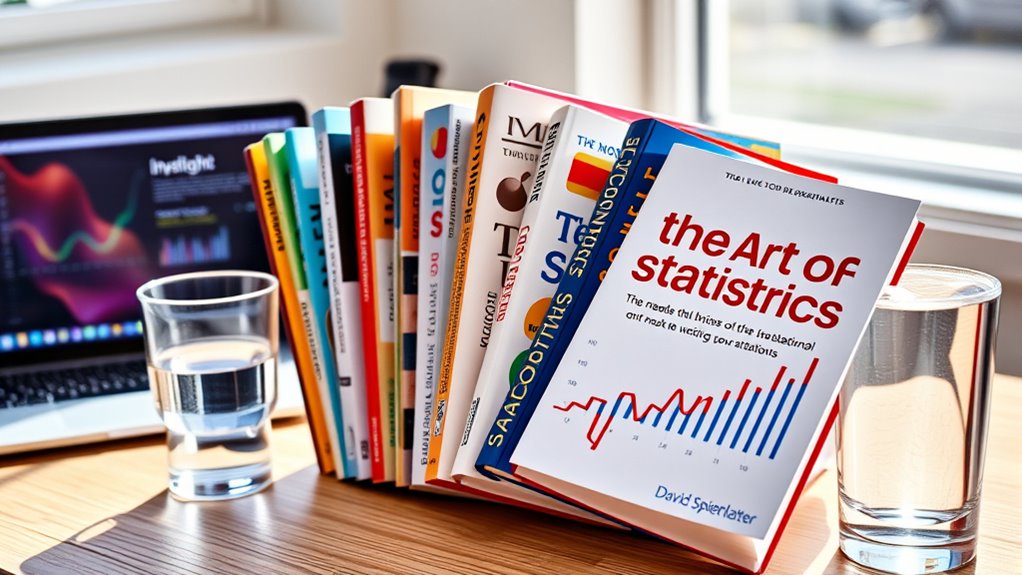
Understanding data is essential for making informed decisions, and *The Art of Statistics: Learning From Data* by David Spiegelhalter offers a clear and practical approach to this. You’ll learn how statistics helps you interpret and describe the world through data, emphasizing the importance of reliable and valid measurements.
The book highlights common data challenges like bias and variability, teaching you how to *guarantee* your data is precise and repeatable. It introduces concepts like statistical inference, probabilistic frameworks, and methods such as bootstrapping and confidence intervals, empowering you to assess uncertainty.
Real-world examples—from health studies to election polls—illustrate how statistics influences decision-making and policy. This book encourages critical thinking, helping you understand the limits of data and avoid false conclusions, making it an excellent resource for beginners.
An Introduction to Statistical Learning by Gareth Hastie, Robert Tibshirani, and Jerome Friedman
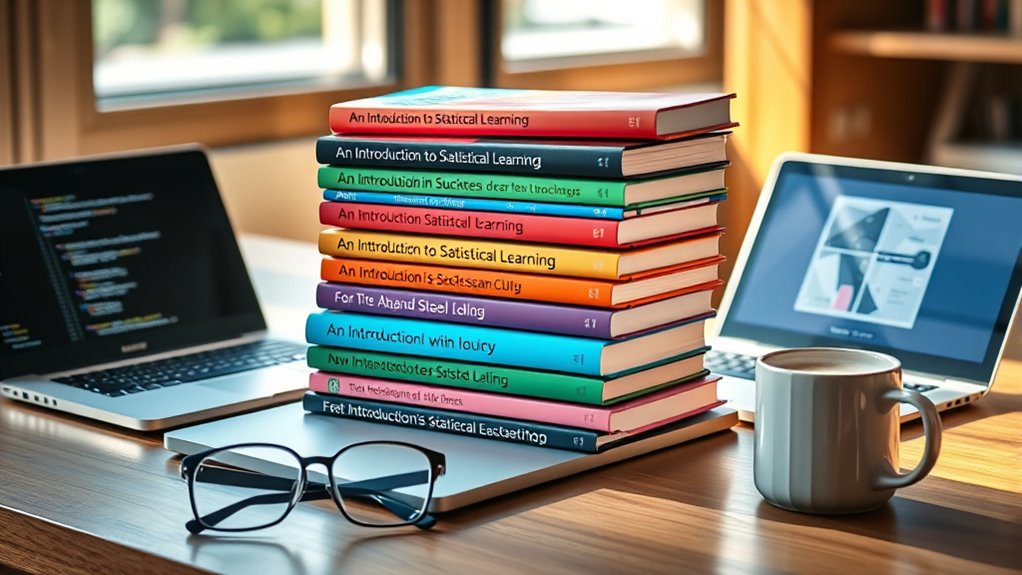
Are you interested in learning modern statistical methods that are both practical and accessible? *An Introduction to Statistical Learning* by Gareth Hastie, Robert Tibshirani, and Jerome Friedman offers a clear overview of key techniques used in data analysis.
Whether you prefer R or Python, this book provides editions tailored to your programming choice, making it versatile for learners. It covers foundational topics like regression, classification, and resampling methods, along with advanced techniques such as tree-based models and support vector machines.
The book emphasizes real-world applications, including exercises and labs to reinforce your understanding. Designed for those without extensive statistical backgrounds, it simplifies complex concepts, making statistical learning approachable and engaging.
Updated editions ensure you’re learning the most current methods in the field.
Probability: Theory and Examples by Rick Durrett

Building a solid foundation in statistical learning often requires a strong grasp of probability theory, which underpins many analytical techniques. *Probability: Theory and Examples* by Rick Durrett offers a rigorous yet accessible approach to the subject, emphasizing real-world applications alongside mathematical precision.
This book focuses on measure-theoretic probability, covering essential topics like laws of large numbers, central limit theorems, and Brownian motion. With over 200 examples and nearly 450 exercises, it encourages active learning and practical understanding.
Designed for graduate students with a background in measure theory, it provides a *thorough*, structured treatment of probability spaces, random variables, and key theorems. The latest editions include advanced topics, such as multidimensional Brownian motion, making it a valuable reference for researchers and advanced learners alike.
Additionally, understanding data privacy challenges is increasingly important for statisticians working with large datasets in various industries. A solid grasp of probability models can also aid in developing better methods to address these challenges effectively.
Kaggle Datasets and Competitions
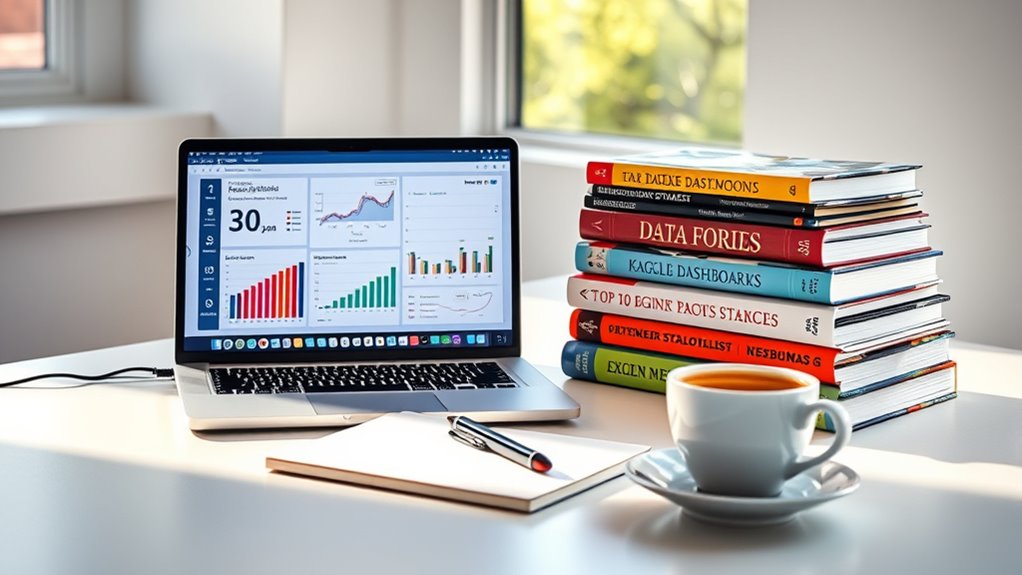
Kaggle offers a dynamic platform where data scientists and enthusiasts can access a wide variety of datasets and participate in competitions that challenge their skills. You can explore datasets across domains like finance, healthcare, sports, and more, then share your projects or collaborate with others. You might also discover holistic care models that emphasize social determinants of health, enriching your understanding of comprehensive data approaches. Competitions range from smaller challenges to large-scale events with massive datasets, helping you develop skills in handling real-world, complex data. The platform’s community forums and detailed documentation support your learning, offering guidance and feedback. Participating in these contests not only sharpens your analytical abilities but also enhances your resume and opens career opportunities. Whether you’re a beginner or experienced, Kaggle provides a practical environment to grow your data science expertise through engaging, hands-on experience.
Frequently Asked Questions
Which Book Best Explains Statistical Concepts for Complete Beginners?
You’re asking which book explains statistical concepts best for complete beginners. You should look for one that offers clear explanations, real-world examples, and accessible language.
For instance, “Elementary Statistics” by Triola breaks down concepts simply and uses practical applications, making it easier for you to understand.
Focus on books that include practice problems and interactive resources, helping you build confidence as you learn foundational statistical ideas.
How Do These Books Incorporate Real-World Data Examples?
They say, “Seeing is believing,” and these books prove that with real-world data examples. You’ll find practical applications like analyzing opinion polls, self-driving car data, or everyday life scenarios.
They actively engage you with videos, software tools, and exercises that use actual datasets. By working through real examples, you develop critical thinking and practical skills, making complex concepts more relatable and easier to grasp in your journey to understanding statistics.
Are These Books Suitable for Self-Study Without Prior Math Experience?
You can definitely find these books suitable for self-study without prior math experience. They focus on clear explanations, real-world examples, and practice problems that help you grasp concepts easily.
Many also include interactive resources and software integration to reinforce learning. Start with foundational topics like descriptive statistics and use practical tools like Excel or R to build your skills gradually.
Engaging with online communities can also boost your understanding.
Do Any of These Books Cover Software Tools Like Python or R?
You wanna know if these books cover software tools like Python or R. Some do, especially those focused on data science and programming.
For example, “Probabilistic Programming & Bayesian Methods for Hackers” uses Python, while “Statistics and Prediction Algorithms Through Case Studies” employs R. “Advanced R” dives deep into R programming.
If you’re looking to learn software alongside statistics, these books are a solid choice.
Which Book Offers the Most Intuitive Approach to Understanding Probability?
Imagine learning to navigate a new city with a friendly local guiding you—this is how An Introduction to Probability feels. It offers the most intuitive approach, breaking down complex ideas into simple, relatable concepts.
You’ll find it like chatting with a knowledgeable friend, making probability easy to grasp. This book’s practical explanations help you understand uncertainty clearly, making it the best choice for beginners wanting a friendly, straightforward introduction.
Conclusion
Immerse yourself in these dynamic data-driven books and develop your statistical skills swiftly. Whether you’re a beginner or brushing up your basics, these top titles tackle tactics, theories, and techniques to transform your understanding. With wisdom woven through words, you’ll willingly wander into the world of statistics, mastering methods with motivation and momentum. Start studying today, and see your skills soar as you seize the secrets of statistics and succeed in your scientific pursuits!


